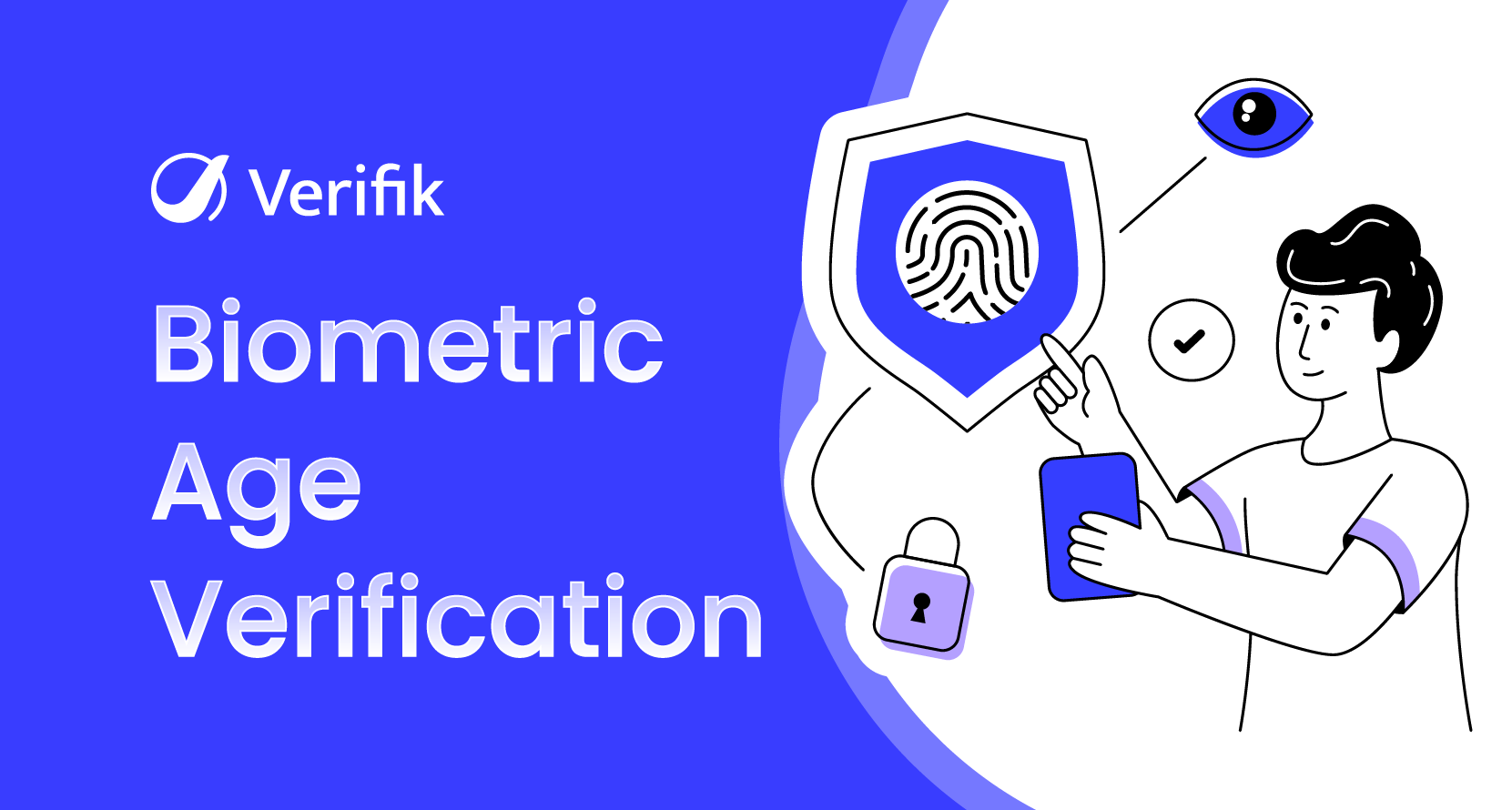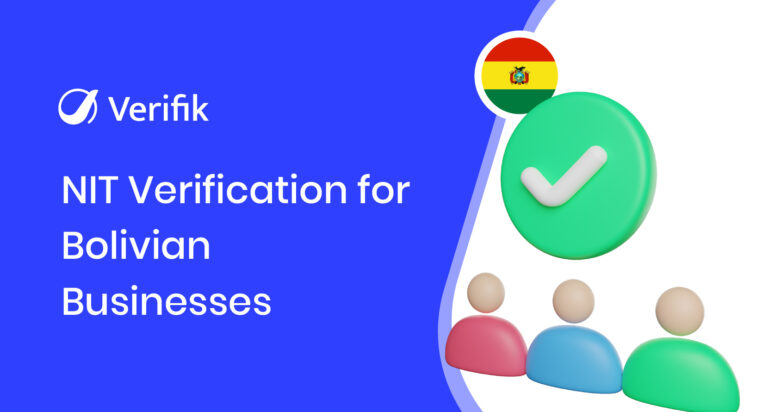Let’s face it: asking someone if they’re 18+ with a simple checkbox has never stopped a teenager from clicking “Yes.” If your business deals in age-restricted content or products, keeping minors out isn’t just a good practice. It’s a legal requirement. And relying on outdated age checks, like uploading a photo of an ID or ticking a box, won’t protect you from fines or reputational damage.
Biometric age verification changes the game. It’s a smarter and faster way to make sure users are actually who they say they are. In this blog, we’ll walk you through how it works, why it’s more reliable than traditional methods, and how it helps businesses stay compliant while keeping things simple for users. Let’s get into it!
Why Traditional Age Verification Falls Short
Let’s look at how most websites or apps try to verify age:
- Upload an ID
- Wait for someone to review it manually
- Or worse, just confirm your age by selecting a birth year
These steps might look responsible on paper, but they are easy to bypass. Teenagers are tech-savvy and determined, and they know how to borrow IDs, fake information, or find loopholes in the system.
There’s also the human error factor. Manual checks can miss inconsistencies, and they often create delays that frustrate real users. On top of that, regulators are getting stricter and more vocal about companies that don’t have strong verification practices.
The bottom line is simple. Traditional age checks are no longer enough.
What Is Biometric Age Verification?
Biometric age verification is a digital method of verifying a user’s age using facial recognition or other biometric data like voice or iris patterns. It’s designed to ensure that only users who meet the required age criteria can access certain products, services, or content. By analyzing facial features like skin texture, bone structure, and overall appearance, AI models can determine whether someone meets the required age threshold, typically 18 or 21.
While some systems may support additional biometric traits such as iris or voice, facial analysis is the most commonly used method due to its speed, accuracy, and ease of use. To strengthen the verification process, many platforms also offer document-based checks as a backup, ensuring both security and compliance with age-restriction laws.
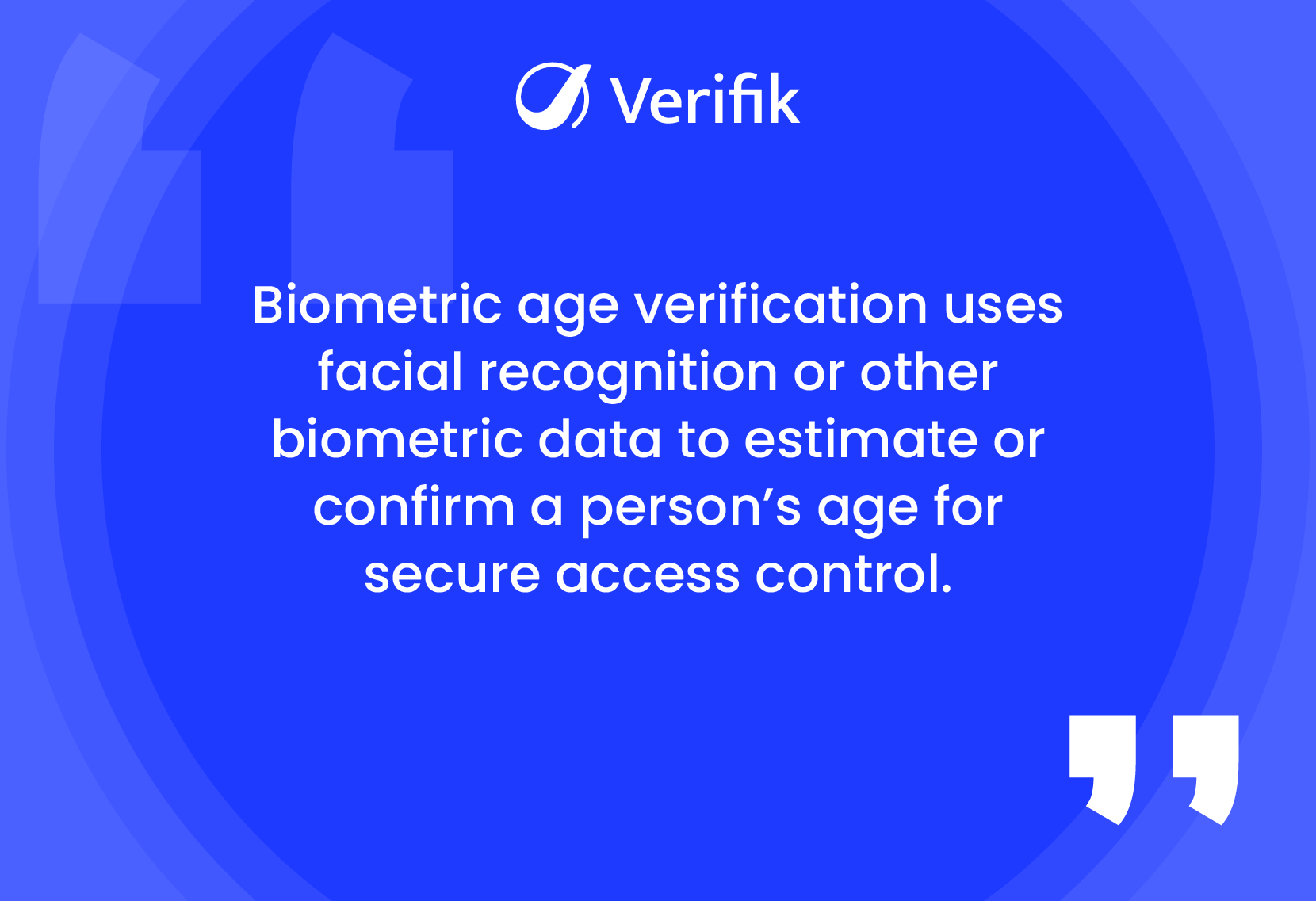
How A Typical Biometric Age Verification Solution Works
Biometric age verification is a major component of the global age assurance market, which is projected to grow from $5.7 billion in 2025 to $10.4 billion by 2029, almost doubling in five years. This growth reflects the rising demand for secure and user-friendly age checks across industries.

Here’s how a standard biometric age verification process typically works:
Step 1: AI-based Age Estimation
A machine learning model analyzes the user’s facial features to estimate age. These models are trained on millions of diverse images and adjusted to ensure fairness across age groups, genders, and ethnicities.
Step 2: Passive Liveness Detection
To ensure the scan is coming from a real person and not a photo or deepfake, passive liveness detection silently checks for signs of life like micro-movements or texture inconsistencies.
Step 3: Smart Decision-Making
If the system confidently detects the user is over the legal age (e.g., 18 or 21), access is granted instantly. If not, the user may be prompted to complete an additional check, like uploading an ID.
This tiered approach balances security, privacy, and convenience.
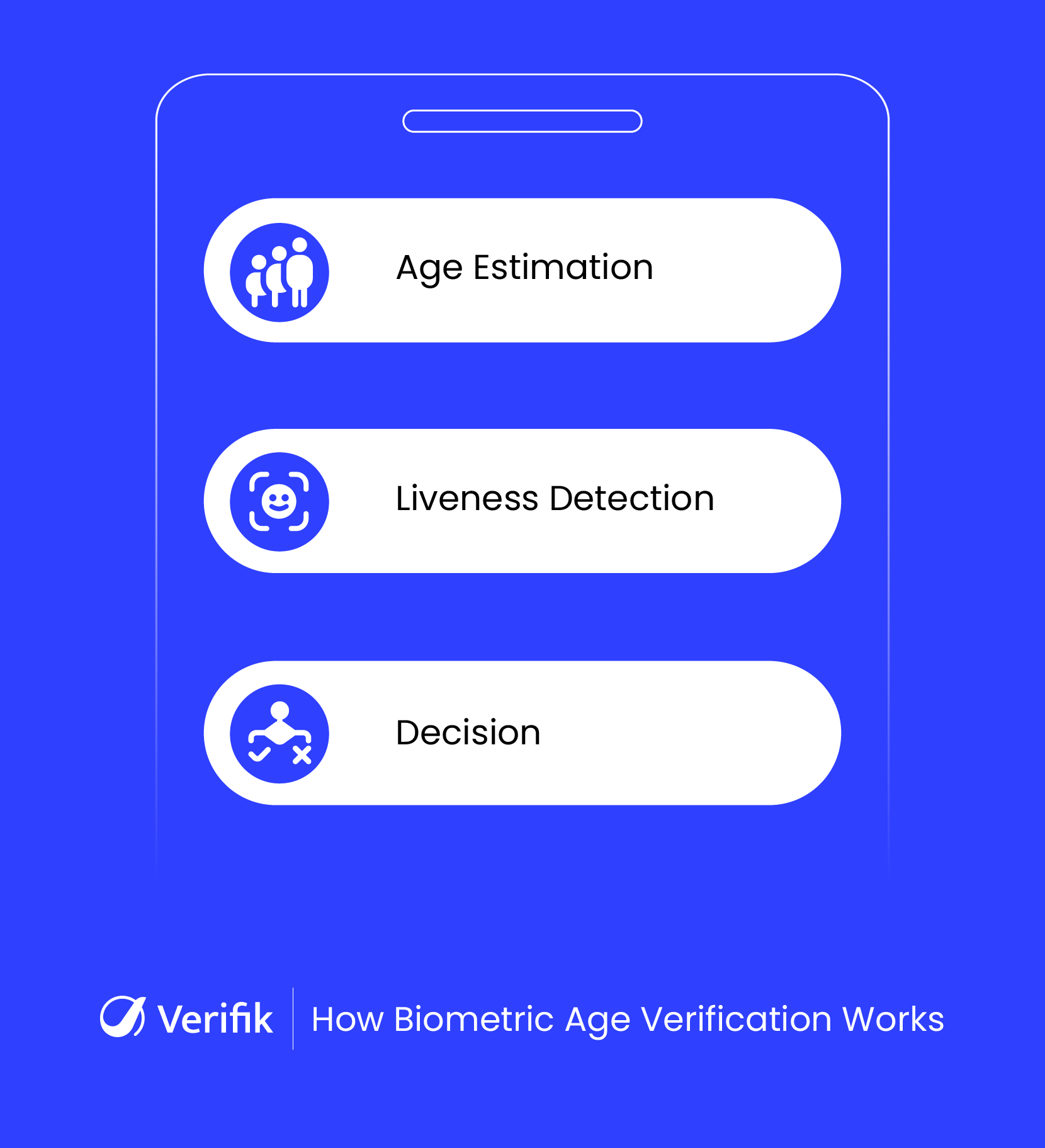
Benefits of Using Biometric Age Verification
Businesses handling age-restricted content or products have grown wary of traditional age verification methods. Pop-up declarations and checkbox agreements barely slow underage users down. That’s why many are switching to biometric age verification. Here’s why it’s the smarter and more secure option:
1. Higher Accuracy
Biometric systems powered by AI are trained on vast datasets covering a wide range of facial features, skin tones, and age groups. This allows them to estimate a user’s age with surprising precision, especially when compared to users manually entering a fake birthdate.
While no system can guess the exact birth year from a face alone, biometric verification models are incredibly effective at distinguishing whether a person falls above or below legal age thresholds such as 13, 18, or 21. That’s what most age-gated platforms really need. And for even more assurance, you can layer this with document checks or escalate suspicious cases to manual review.
2. Real-Time Verification
Speed is critical in any online experience. Users today are quick to abandon sign-up flows that ask for too much effort. Biometric age verification, especially facial age estimation, is built for real-time processing. A quick scan using a webcam or phone camera can return a result within seconds.
That means fewer drop-offs, smoother onboarding, and faster access for eligible users. Whether you’re running a gaming site, an alcohol delivery platform, or an adult content service, this kind of frictionless verification can make a real difference in conversion rates.
3. Scalability
Biometric systems are built to handle growth. Whether your platform serves a few hundred users or processes millions of requests daily, facial recognition technology can scale without compromising on speed or performance. This makes it a future-proof solution for startups expecting growth or large enterprises managing global user bases.
Cloud-based biometric tools can be deployed across different platforms—web, mobile apps, kiosks—without needing heavy infrastructure investment. And because there’s no reliance on human intervention, you can verify users 24/7, anywhere in the world, with consistent accuracy and speed. This scalability makes biometric age verification a smart long-term investment for platforms in any industry.
4. Harder to Bypass
Age gates that rely on checkboxes or ID uploads are easy targets. Most teens know how to grab a sibling’s ID or type in a fake date. But biometric verification adds a strong layer of defense that is far more difficult to spoof.
Built-in passive liveness detection helps ensure the face presented is real and not a printed photo or a replayed video. Some systems can even detect the subtle movements or reflections that distinguish a live person from a static image. This makes it almost impossible for someone to trick the system using stolen or borrowed credentials.
5. Better User Experience
Biometric age verification also strikes a better balance between security and ease of use. Users don’t need to search for physical documents or fill out lengthy forms. Instead, they simply allow a facial scan, which typically takes less than five seconds.
This creates a more user-friendly journey, especially for mobile-first users who are used to camera-based actions like Face ID. The process is fast, non-intrusive, and requires minimal effort. Only users flagged as potentially underage are asked to go through further steps, keeping things light for the majority while still being strict where it matters.
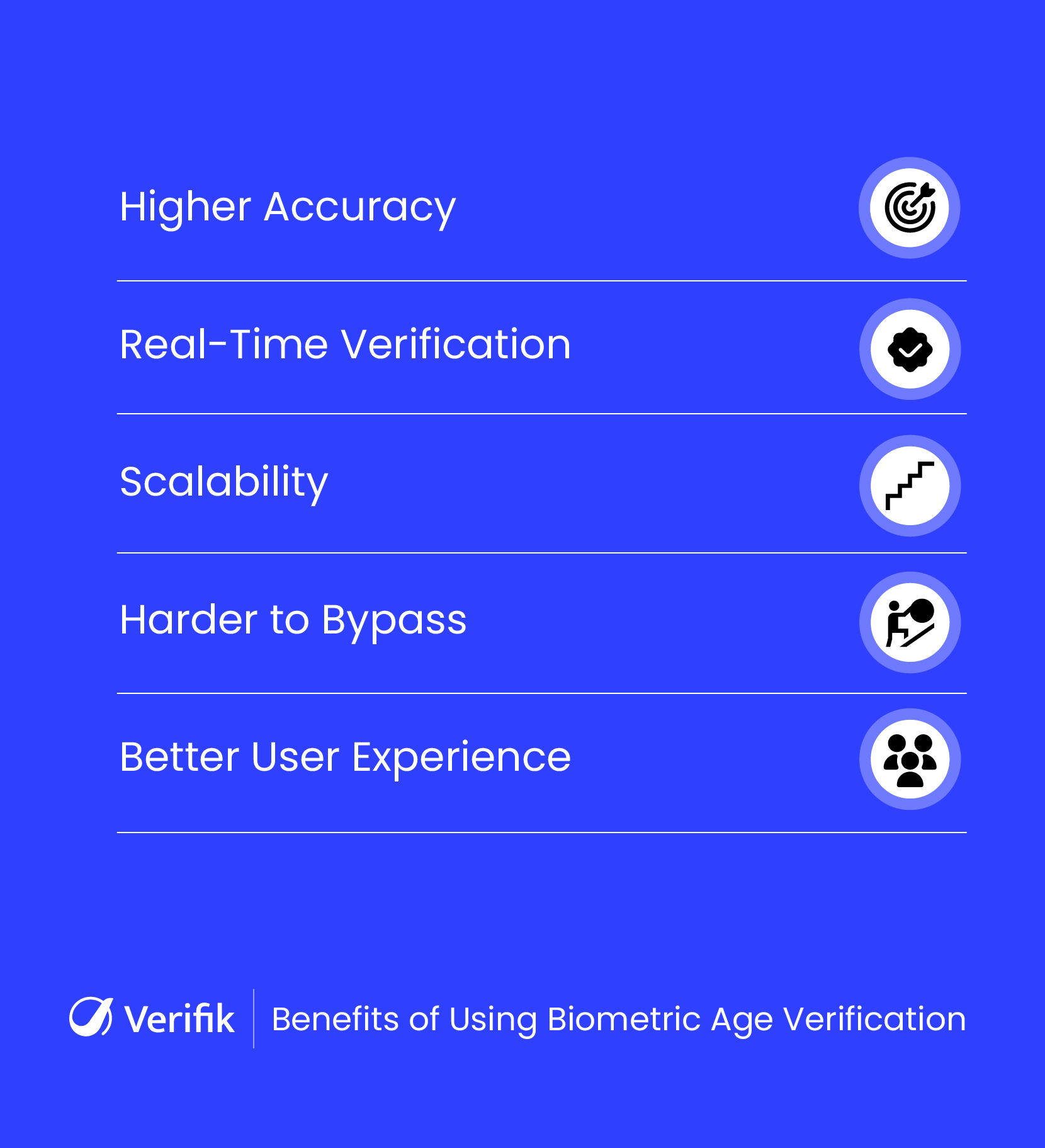
Industries Use Cases of Biometric Age Verification
Biometric age verification is no longer limited to high-risk platforms. It is now being used across various sectors where age matters:
Online Gaming and Gambling
Online gaming and gambling platforms are under growing pressure to prevent underage access. With age-restricted games, loot boxes, and real-money betting, ensuring that users meet the minimum age requirement is not just good practice, it is a legal necessity. Facial recognition allows platforms to verify age in real time without disrupting the user experience.
Instead of relying on manual document uploads or user-submitted birthdates, platforms can instantly assess a user’s eligibility through a quick face scan. This not only deters minors but also helps prevent repeat offenders or bots from returning with fake accounts. For gaming operators, it creates a safer, more compliant environment.
E-commerce for Alcohol, Vape, and Cannabis
Online retailers selling alcohol, vape products, or cannabis must confirm that buyers are of legal age before completing any transaction. Traditional ID checks often add friction and can easily be bypassed. Biometric age verification offers a faster and more secure alternative by confirming a buyer’s age using just their face.
With a quick scan during checkout, businesses can automatically screen underage users and reduce the risk of selling to minors. It also helps ensure that deliveries are made to the right individuals. For regulated products, this level of real-time verification offers peace of mind for both platforms and customers.
Streaming and Adult Content
Streaming platforms that host adult or mature content are required to put stronger age barriers in place. Relying on self-declared birthdates or simple checkboxes is no longer considered effective or responsible. Biometric verification allows content providers to confidently restrict access using real, physical proof of age.
A short facial scan at the point of access makes it easier to block underage viewers while maintaining a seamless experience for adults. It also helps platforms comply with growing legal requirements around child protection, especially in regions where fines and penalties for non-compliance are becoming more severe.
Fintech and Cryptocurrency Platforms
Age is a crucial part of the identity verification process for financial services, especially in fintech and crypto. Whether someone is opening a digital wallet, registering for a trading app, or applying for a loan, platforms must ensure that users are both real and of legal age to engage with financial products.
Facial recognition offers a quick, contactless way to validate age during onboarding. By combining biometric verification with optional document fallback, fintech platforms can reduce fraud, prevent fake accounts, and speed up sign-ups without sacrificing regulatory compliance. It’s a smarter, more scalable way to meet KYC and AML requirements.
Healthcare and Wellness Platforms
Healthcare apps and wellness services often offer treatments or products that are not suitable for minors. From prescription drugs to age-specific supplements, verifying user age is essential for safety and compliance. With biometric verification, platforms can handle this step efficiently and without collecting excessive personal data.
A facial scan at registration or checkout allows healthcare providers to ensure the user meets the minimum age requirement before access is granted. This reduces the need for manual ID checks and protects the platform from liability. It also helps build trust with users by showing that safety is a top priority.
What to Look for in a Biometric Age Verification Solution
Not all biometric systems are created equal. When choosing a provider or integrating a solution, ask the following:
- Does it use AI-powered facial age estimation with high accuracy?
- Is passive liveness detection built into the flow?
- Is document verification included as a fallback, not the first step?
- How fast and seamless is the user experience?
- Is the system compliant with privacy regulations and doesn’t store biometric data unnecessarily?
- Can it adapt dynamically, verifying more deeply only when needed?
Choosing the right solution isn’t just about ticking boxes. It’s about creating trust, safety, and usability for everyone on your platform.
Why This Technology Matters More Than Ever
The demand for biometric age verification is rising for a reason. Today’s users expect smooth digital journeys. Regulators expect airtight compliance. And platforms must deliver on both.
Trying to enforce age restrictions with forms and PDFs is like trying to secure a vault with a bicycle lock. It might work for a while, but it’s only a matter of time before it fails.
Biometric age verification offers a better way forward. It protects your platform and keeps you compliant, all while reducing onboarding friction and enhancing trust with users.
The Bottom Line
Biometric age verification is no longer a futuristic concept. It’s already being used by major platforms to stay compliant, reduce fraud, and create safer digital spaces. Unlike traditional verification methods, it balances accuracy, speed, and user experience while keeping bad actors out.
As age-sensitive platforms continue to grow, the need for smarter, more scalable verification will only become more urgent. If your business depends on keeping minors out, biometric verification is your best bet for getting it right.
Ready to Add Smart Biometric Age Verification to Your Platform?
Verifik’s smartENROLL lets you build a seamless age verification process that adjusts based on risk. Start with quick data checks. Add facial age estimation when needed. Escalate to document verification only when absolutely necessary.
It’s simple. It’s fast. It works.
- Block underage users with certainty.
- Keep onboarding fast and friction-free.
- Stay compliant.
Let us show you how smartENROLL can modernize your age verification in under 30 minutes. Book your free demo today!









